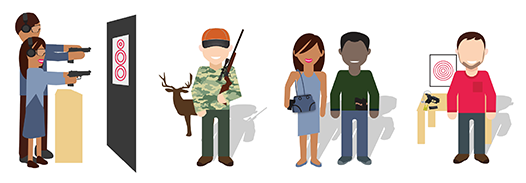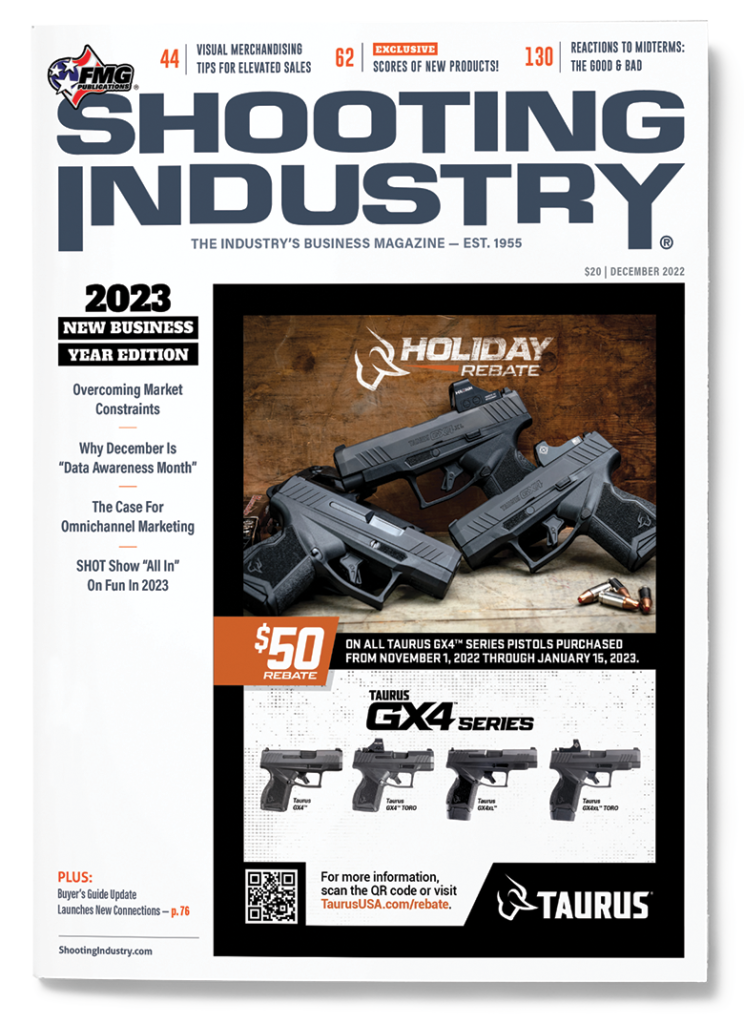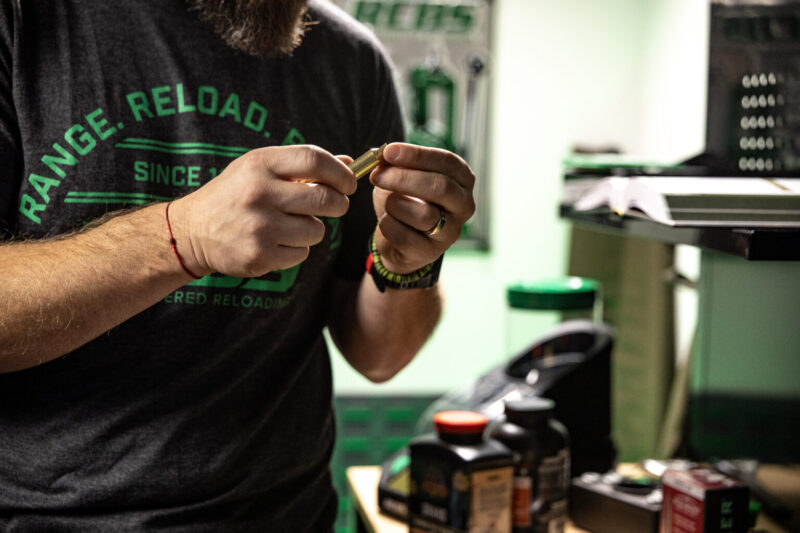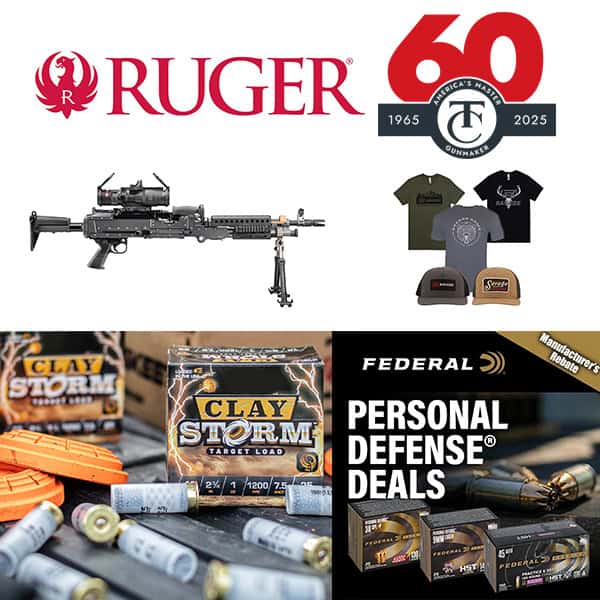Do You Really Know Your Firearms Customers?
What motivates Americans to buy firearms? According to new research from Southwick Associates, there’s no single answer. American gun owners are spread from coast to coast with motivations as varying as the beaches, mountains, rivers and deserts in between. Age, marital status, ethnicity, education and personal experiences all play a role in the decision to buy a firearm — but how do those factors align with your customers?
By better understanding why customers make a purchase, Southwick Associates’ new market research will help businesses improve their product mix, marketing efforts and consumer interactions to drive more sales.
“We looked at what first made people aware they wanted to buy a firearm,” said Nancy Bacon, Southwick Associates VP. “Then, we examined how they research their preferred firearm, where they get information and how their preferences shift during the purchasing process.”
This study, now available in a comprehensive 120-page report from Southwick Associates, describes the full purchase journey customers traverse when buying a firearm and presents five distinct customer segments, or personas, your company should know well.
“This report defines the segments based on their motivations to purchase their most recent firearm,” Bacon noted. “And, it backs that up with answers to purchase-journey questions that give us an overview of what the differences between different segments are.”
Do You Know The Average Joe?
Although nearly 20 million firearms were purchased in the U.S. last year, averaging those buyers into a single profile results in a misleading picture. The “average” firearm customer would be a 46-year-old white male making $75,000 per year. However, numbers of female, Hispanic and African American buyers are on the rise and their experiences and demands are creating new business opportunities for firearm retailers.
Even when customers look the same, their reasons for wanting a firearm can be much different. Building a sales strategy around how customers look is “smart” — if you want to minimize your business.
“As you’ve no doubt seen, everybody’s motivation for purchasing a firearm is a little different,” said Bacon. “When you have somebody purchasing to build their skills versus someone who’s purchasing to go hunting or because they have crime in their area — your marketing is going to be completely different for each one of them.”
This concept — knowing a customer’s demographic appearance doesn’t dictate their interests — was the driver behind Southwick Associates’ latest research. By examining the motivations for buying firearms, and using advanced statistical methods to separate them into individual groups based on their reasons for wanting to purchase a firearm, five distinct customer groups, or personas, emerged — representing all U.S. firearm consumers. Let’s take a look at each below.
The Skills Builder
Shooting’s built-in educators, Skills Builders are one of the youngest segments purchasing firearms today. These savvy shooting sport enthusiasts are driven by a desire to become expert target shooters, but also love socializing on the range and learning about the best and newest gear on the market. The Skills Builder group is also one of the least effective to target with advertisements focused on self-defense and protection.
“These people want to build their skills and enjoy target shooting,” Bacon explained. “Skills Builders describe themselves as dependable, outdoors-oriented and protective people. But the demographics of precisely who they are and where they live might surprise you.”
What drives Skills Builders to buy? From awareness to post-purchase, their journey as a customer looks dramatically different than that of other segments.
These intense researchers go to great lengths to learn about potential purchases before they buy: 94% of them investigate buys beforehand, and it’s during the research phase where marketing efforts can be best focused.
Innovation in the marketplace is a key factor in driving purchase decisions for this group. But what are the best ways to reach them? The top social media platforms and research methods for Skills Builders are detailed in the complete report.
“When you have somebody purchasing to build their skills versus someone who’s purchasing to go hunting or because they have crime in their area — your marketing is going to be completely different for each one of them.”
Nancy Bacon, VP
Southwick Associates
The Family Guardian
Who is the Family Guardian? You might have guessed this segment is highly protective, but did you know many Family Guardians would choose to purchase a different firearm if they could rewind the clock? These buyers are generally in a hurry to purchase and less concerned about securing the best deal possible.
This largest segment of firearm consumers is deeply concerned about crime, social unrest and the political climate — so much so, a significant portion of their purchase journey is driven by the news. Family Guardians are customers who look to firearms for a sense of security, with very different goals than a recreational shooter like the Skills Builder and even other protection-oriented consumers.
“This person is really trying to make sure they can protect themselves and their family,” Bacon explained. “They’re one of three profiles in our protection group. They may have had a dangerous personal experience driving that decision. They’re also heavily encouraged to go purchase by family and friends. And they don’t buy as often, so when they do, it’s important to make it count.”
The full report contains other details for the Family Guardian including frequency of visiting ranges, how likely they are to be converted into regular customers like recreational shooters, how they differ from the average firearm buyer and more.
The Urban Defender
In some ways, the Urban Defender is a polar opposite of the Skills Builder. These customers want to be competent in their handling abilities and skill set. However, many of them have never been to a shooting range before deciding to purchase a firearm. In general, these customers live in communities where firearm ownership is less common — and not always appreciated.
As such, acquiring the latest and greatest gear or heading to the range is significantly less important to them. Urban Defenders primarily feel unsafe in their environments and are mistrustful of those they encounter on a regular basis. In general, it drives this segment to seek out lightweight, concealable weapons that enable them to rely on themselves and not others for personal protection. Being new to firearms, and with limited support from their community, lessons are a popular add-on for this segment.
Urban Defenders feel increased pressure to purchase a firearm before sales are further restricted, but generally do not tend to follow up their purchase with repeat sales of accessories. However, certain aftermarket additions to their initial purchase can improve your profit margins when selling to an Urban Defender, as detailed in the complete report.
Age, marital status, ethnicity, education and personal experiences all play a role in the decision to buy a firearm — but how do those factors align with your customers?
Prepared For The Worst
Perched midway between Urban Defender and Family Guardian, the Prepared For The Worst segment accounts for around 20% of gun buyers in the U.S. Unlike Urban Defenders, buyers who are “prepared for the worst” generally do not feel unsafe in their daily environment. They do, however, still feel a strong pull to develop shooting skills to build confidence in their ability to take care of themselves and not depend on others.
While it may be tempting to drop this segment in a bucket with other protector segments, there are some key differences among these buyers that make them worthy of separate attention. Notably, Prepared For The Worst customers are perfectionists. They do not make a new purchase or take on a new activity if they cannot go all-in. Once they purchase their firearm, they will actively work to develop their shooting skills at the range and tend to have a significant amount of leisure time in which to do so.
They may not possess the same passion for firearms the Skills Builder has, but they are intentional and detailed in developing competent firearm skills for their own protection.
Details regarding the percentage who are married, which geographic regions are they most prolific in and their typical ages are in the complete report available from Southwick Associates.
The Hunter
Thirty-nine million hunting licenses and permits were sold in the U.S. last year, making the Hunter one of the most valuable segments in the market. Hunters comprise a smaller market share than some other segments, but they are substantially active customers. Long a bastion of firearms advocates and repeat customers, understanding the latest trends among hunters can provide a consistent stream of revenue to your business.
It’s no secret messages aimed at this persona should differ significantly from customers in protection segments, but buying motivations even between Hunters and fellow recreational shooters like Skills Builders can also vary wildly.
While home protection is still one of many motivating factors, the goals of this segment are more geared toward community building. For some Hunters, bringing meat to the table is a primary motivation. Others favor adventure and social interaction outdoors.
Hunters typically grow up entrenched in social groups where gun ownership is encouraged and support is there for pursuing their passion. However, trends over time have changed the way this reliable group of customers consumes marketing messages and decides which purchases to make. Many new Hunters rely on online communities for social support versus their immediate family and neighbors.
Interestingly, Hunters are most active on slightly different social media networks than protection segments like Urban Defenders and Family Guardians. They also tend to frequent slightly different retailers than those segments.
What primary motivations go to into a Hunter’s decision to purchase a new firearm? What are the biggest influencing factors in that decision? How should your retail staff interact with potential new customers? The latest market insights on Hunters are detailed in the full, 120-page report from Southwick Associates.
In Closing
A one-size-fits-all marketing approach will not work across the five unique firearm personas shared above.
“This report was generated during two phases,” said Bacon. “We not only wanted to understand why people purchased their most recent firearm, but we also went back to look at the details regarding their purchase journey. We found out what happened after the firearm purchase and to who.”
Order the complete report to find out which social influences affect gun buyers the most, which social networks each segment leans most heavily on, which ethnicities comprise each segment and what kind of media outlets impact their buying decisions the most.
To order the report, or to ask questions, contact Nancy Bacon at Nancy@SouthwickAssociates.com.







